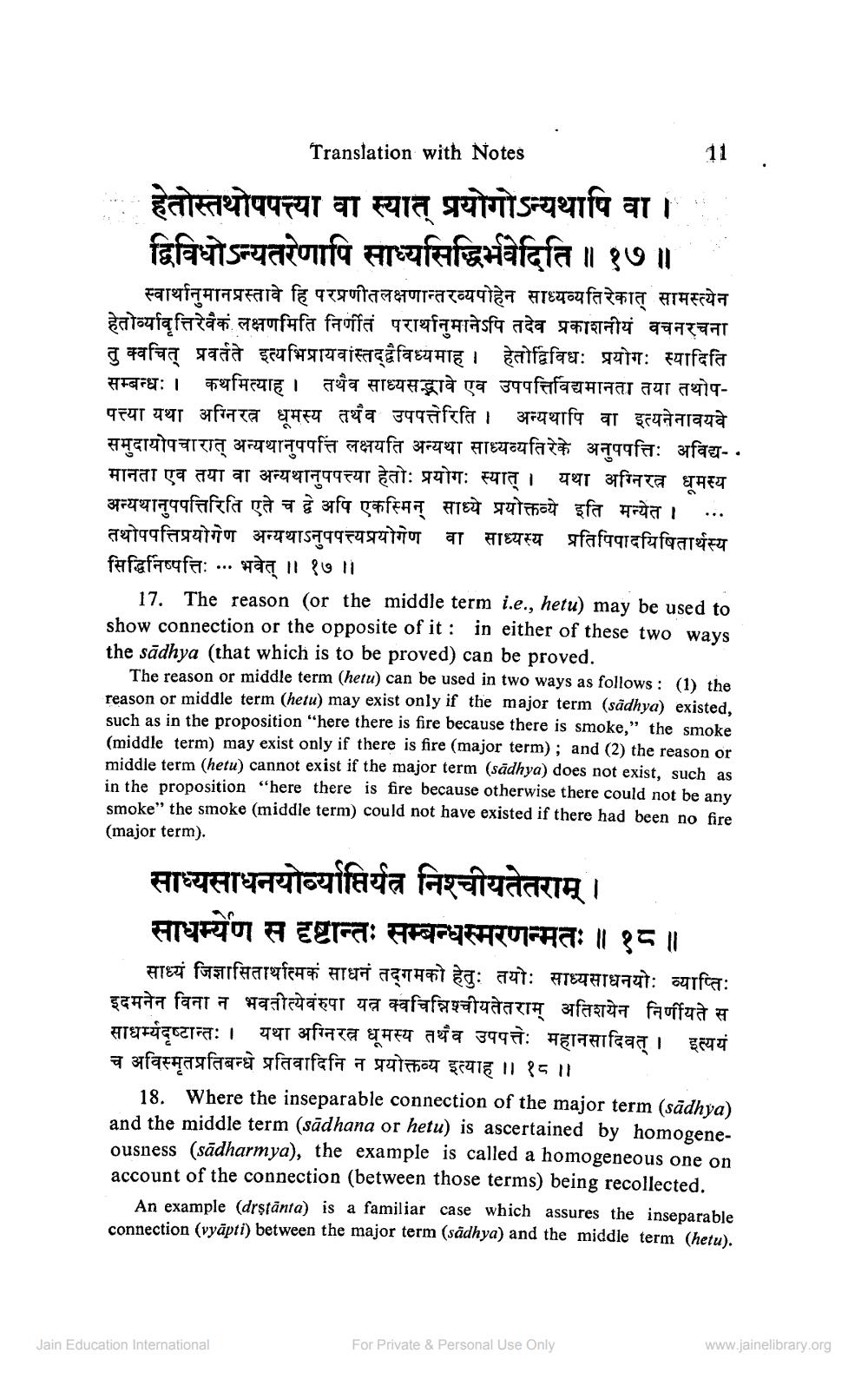________________
Translation with Notes
तोस्तथोपपत्त्या वा स्यात् प्रयोगोऽन्यथापि वा । द्विविधो ऽन्यतरेणापि साध्यसिद्धिर्भवेदिति ॥ १७ ॥
स्वार्थानुमान प्रस्तावे हि परप्रणीतलक्षणान्तरव्यपोहेन साध्यव्यतिरेकात् सामस्त्येन हेतोर्व्यावृत्तिरेवैकं लक्षणमिति निर्णीतं परार्थानुमानेऽपि तदेव प्रकाशनीयं वचनरचना तु क्वचित् प्रवर्तते इत्यभिप्रायवांस्तद्द्द्वैविध्यमाह । हेतोद्विविधः प्रयोगः स्यादिति सम्बन्धः । कथमित्याह । तथैव साध्यसद्भावे एव उपपत्तिविद्यमानता तया तथोपपत्त्या यथा अग्निरत्र धूमस्य तथैव उपपत्तेरिति । अन्यथापि वा इत्यनेनावयवे समुदायोपचारात् अन्यथानुपपत्ति लक्षयति अन्यथा साध्यव्यतिरेके अनुपपत्तिः अविद्य- . मानता एव तथा वा अन्यथानुपपत्त्या हेतोः प्रयोगः स्यात् । यथा अग्निरत्र धूमस्य अन्यथानुपपत्तिरिति एते च द्वे अपि एकस्मिन् साध्ये प्रयोक्तव्ये इति मन्येत । तथोपपत्तिप्रयोगेण अन्यथाऽनुपपत्त्यप्रयोगेण वा साध्यस्य प्रतिपिपादयिषितार्थस्य सिद्धिनिष्पत्ति: ... भवेत् ॥ १७ ॥
17. The reason (or the middle term i.e., hetu) may be used to show connection or the opposite of it: in either of these two ways the sādhya (that which is to be proved ) can be proved.
The reason or middle term (hetu) can be used in two ways as follows: (1) the reason or middle term ( hetu) may exist only if the major term (sādhya) existed, such as in the proposition "here there is fire because there is smoke," the smoke (middle term) may exist only if there is fire (major term); and (2) the reason or middle term (hetu) cannot exist if the major term (sādhya ) does not exist, such as in the proposition "here there is fire because otherwise there could not be any smoke" the smoke (middle term) could not have existed if there had been no fire (major term).
11
साध्यसाधनयोर्व्याप्तिर्यत्र निश्चीयतेतराम् ।
साधर्म्येण स दृष्टान्तः सम्बन्धस्मरणन्मतः ॥ १८ ॥
साध्यं जिज्ञासितार्थात्मकं साधनं तद्गमको हेतुः तयोः साध्यसाधनयोः व्याप्तिः इदमनेन विना न भवतीत्येवंरूपा यत्र क्वचिन्निश्चीयतेतराम् अतिशयेन निर्णीयते स साधर्म्यदृष्टान्तः । यथा अग्निरत्न धूमस्य तथैव उपपत्तेः महानसादिवत् । इत्ययं च अविस्मृत प्रतिबन्धे प्रतिवादिनि न प्रयोक्तव्य इत्याह ।। १८ ।।
18. Where the inseparable connection of the major term (sādhya) and the middle term (sadhana or hetu) is ascertained by homogeneousness (sādharmya), the example is called a homogeneous one on account of the connection (between those terms) being recollected.
An example (drṣtänta) is a familiar case which assures the inseparable connection (vyāpti) between the major term (sādhya) and the middle term ( hetu).
Jain Education International
For Private & Personal Use Only
www.jainelibrary.org




